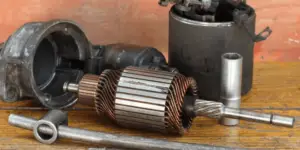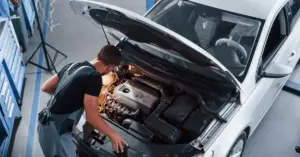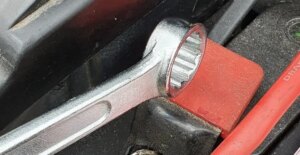So you’ve noticed a greenish or white crystalization on your battery terminals. It’s quite common. In this article, we’ll explore whether the alternator can cause this, whether it’s dangerous and what can be done to reduce it.
Very briefly, though, before we get into the details a little about the relationship between the alternator and the battery. If you know this already, feel free to skip the next few paragraphs.
The charging system on a car consists of a battery, alternator, voltage regulator, and wires. As the car requires electricity to engage the starter, pump fuel, provide the spark for the ignition, and run accessories such as lights and radio when the engine is off, that power is pulled from the battery.
To keep the battery from going dead, the alternator charges the battery. A voltage regulator helps the alternator provide a consistent, safe voltage to the battery. In most cars, the voltage regulator is built into the alternator.
Can An Alternator Cause Battery Terminal Corrosion?
An over or undercharging alternator can cause corrosion on the battery terminals. Corrosion on the battery terminals looks like a crystalline power – technically called sulfation – and is usually white or greenish.
- Corrosion on the positive battery terminal indicates the battery is being overcharged.
- Corrosion on the negative terminal indicates the battery is being undercharged.
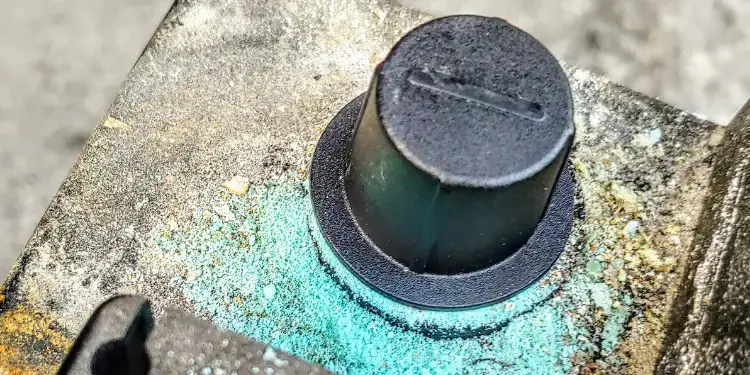
Battery corrosion is the result of chemical reactions taking place.
Cars have lead-acid batteries under the hood. Inside the battery are lead plates and an electrolyte fluid, usually a mix of sulfuric acid and distilled water.
Small amounts of corrosion on either terminal can be normal but excessive amounts can be a sign of a problem with the charging system.
As the battery is charged and discharged, a small amount of hydrogen gas is vented from the battery.
When the charging system is functioning properly, the amount of gas is small and harmless.
If the battery is being over or undercharged, it releases higher amounts of hydrogen gasses which cause corrosion on the battery terminals.
Corrosion forms because the hydrogen gas reacts with the lead battery terminals, the copper battery cables and connectors, and oxygen in the air.
Many visitors read this article next: Car Battery Smells Like Rotten Eggs – Yes, It’s Dangerous
Can Corroded Terminals Drain A Battery
Rarely, the corroded terminals will mean that the battery won’t charge from the alternator and won’t be able to turn the starter motor, as well as if the terminals were clean.
Any corrosion will reduce the current and voltage from the alternator to the battery and from the battery to the starter motor. This is called a high resistance short and can reduce the effectiveness of all your car’s electrical systems that run off your battery when the engine is off.
Many visitors also read these related articles:
Can A Bad Alternator Cause Limp Mode? [ANSWERED]
Do You Have To Replace A Battery When Replacing An Alternator?
What Other Damage Is Caused To The Battery By The Alternator?
Car batteries have a fairly narrow range of what voltage should be in. Otherwise, damage will occur.
A car battery is fully charged, with the engine off at 12.5 volts. If the voltage drops below 12 volts, the car may not start and need to be jump-started.
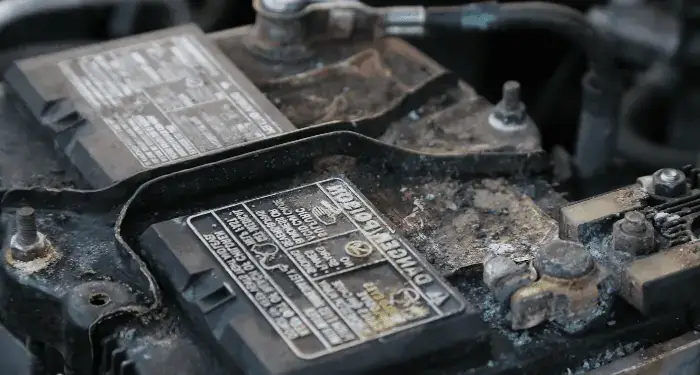
At 10.5 volts, the battery is considered dead. With the car running and the alternator charging properly, the battery voltage will be between 13.5-14 volts. So basically, a car with a good battery and a properly functioning charging system should always be between 12.5-14 volts.
If the alternator is overcharging, it will cause the battery to exceed 14 volts.
Overcharging causes the electrolyte fluid in the battery to boil. The electrolyte boiling produces excess hydrogen gas to be vented from the battery.
This venting gas can be flammable. If this continues long enough, most of the electrolytes will boil out and cause damage to the lead plates inside the battery.
Undercharging causes sulfation which is lead sulfates on the plates in the battery, which reduces the battery’s performance and shortens its lifespan.
Is A Small Amount Of Battery Corrosion Normal?
A small amount of corrosion on the battery terminals is normal. Batteries have small vents on top to let gasses that build up from the charging process escape.
These gasses can have a chemical reaction with the battery cable clamps and cause a small amount of corrosion.
As a battery ages and nears the end of its lifespan, typically 3-5 years, it is more likely to develop corrosion on its terminals.
It’s important to inspect the battery for corrosion and clean it off regularly.
If corrosion builds up, it can cause higher resistance to electricity flowing into and out of the battery. This will result in the battery not charging and difficulty starting the car in the morning.
What happens when your car battery gets wet? Is it always bad expensive? Discover the answer here What Happens When A Car Battery Gets Wet? [POTENTIAL DANGERS]
Is A Battery That Has Been Corroded Salvageable And The Test(s) That Can Be Done To Check

If a problem with the charging system is caught early, the battery can be saved. Any corrosion on the battery terminals should be cleaned with water, baking soda, and a brush.
Because battery acid is harmful, avoid getting any on your clothes or skin. Gloves and eye protection are a good idea when cleaning corrosion off of a battery.
Once the terminals are clean, dielectric grease or something similar can be lightly applied to help prevent new corrosion from forming and to help maintain a good electrical connection.
Because corrosion on the battery terminals can be a sign of damage occurring inside the battery, the problem should be investigated as soon as possible.
A mechanic can use a battery and alternator tester to determine if there is an issue. This tool connects to both battery terminals and reads battery voltage.
With the engine off, this tool will show if the battery is fully charged or if the voltage is low. With the engine running, this tool will measure the voltage the alternator puts out.
This is important.
Often a corroded battery will be replaced in error when the real cause was an undercharging or overcharging alternator. It’s always worth checking the alternator output before replacing the battery; otherwise, your new battery will soon become corroded too.
Other Signs That A Bad Alternator Is Affecting The Battery
If an alternator fails, you will probably notice other symptoms, such as dimming lights, the engine cranking slowly or needing a jump start, or the car stalling.
You may also hear a squealing or grinding noise from under the hood. This is attributed to the alternator bearings failing.
What Are The Other Signs A Bad Alternator Is Putting Out Too Much Charge?
If the alternator overcharges, a gauge or light on the dashboard may indicate an issue.
If the battery appears swollen, that indicates the battery has been overcharged, and hydrogen gas has built up inside the battery.
Battery acid leaking out the vents in the battery is also a sign of overcharging.
In Conclusion
A small amount of corrosion on the terminals is normal and can be cleaned off – gloves and safety goggles should be worn.
Positive terminal corrosion may indicate the alternator is overcharging
Negative terminal corrosion may indicate undercharging.
Always check the alternator is working well before fitting a battery.
Severe terminal corrosion indicates irreparable damage inside the battery.


